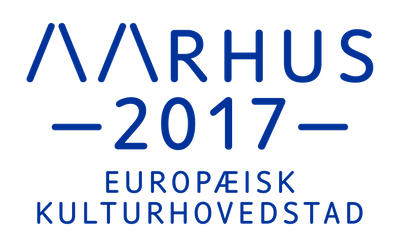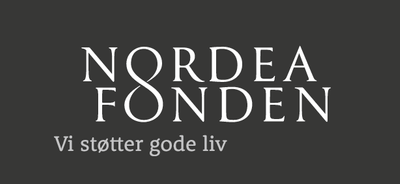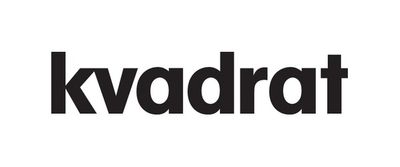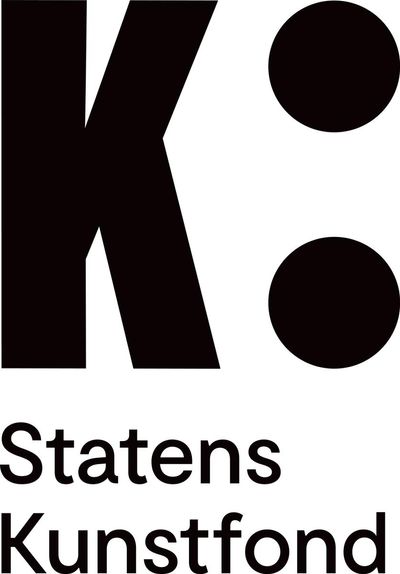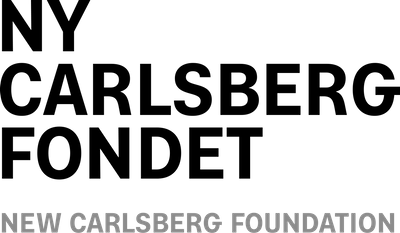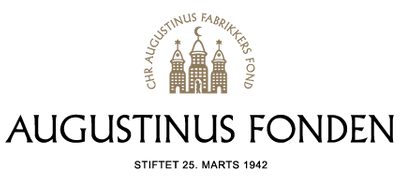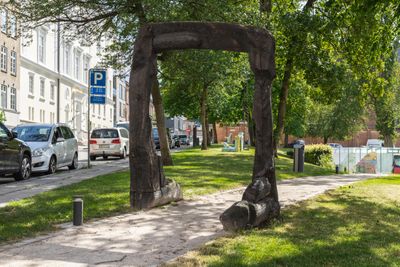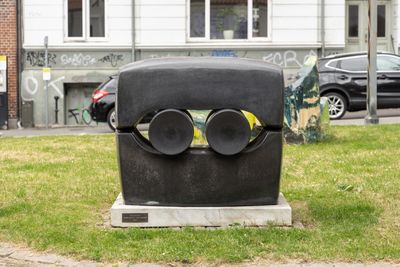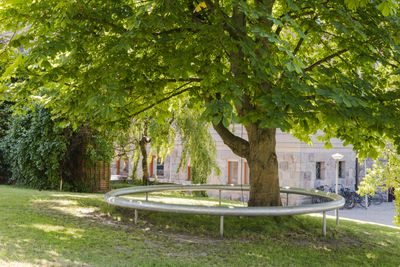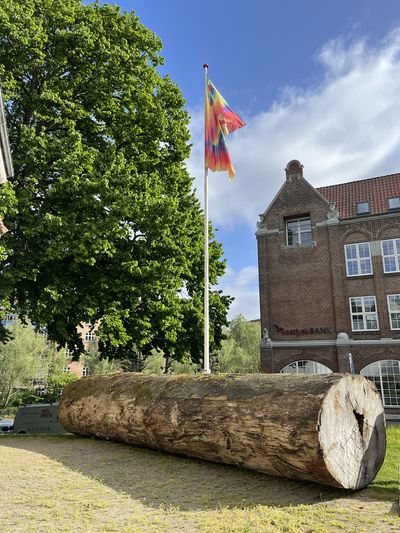Skulpturparken / The Sculpture Park
–
–
Marking the 2017 centenary of Kunsthal Aarhus, the park surrounding Kunsthal Aarhus was transformed into a sculpture park with works by Danish and international artists. Works are continuously added to Kunsthal Aarhus Skulpturpark, which in turn makes it possible for passers-by to experience and perceive art at all hours of the day.
Current
The artwork Hypernormalization by artist FOS functions as entry portal to Kunsthal Aarhus Skulpturpark. His works often show how are our lives are shaped by ideas.
The artwork Hypernormalization by artist FOS functions as entry portal to Kunsthal Aarhus Skulpturpark. His works often show how are our lives are shaped by ideas. Hypernormalization marks a transition – from the outside world to the art institution; from the sidewalk to the park; from the city of Aarhus to Kunsthal Aarhus.
We seldom register such transitions. They are a normal part of our societal behaviour and they can even control this behaviour. For example, who would walk around a portal instead of going through it? Hypernormalization normalises, marks and confirms these transitions.
Hypernormalization was originally created for an exhibition at the French Embassy in Copenhagen, marking the transition from Danish to French territory. The portal is an example of what the artist himself calls ‘social design’ – a hybrid form of art, design, and architecture.
FOS is an alias for Thomas Poulsen (1971, DK), who works with sculpture, design, performance and installation art. He is a graduate of the Royal Danish Academy of Fine Arts, where he studied from 1993 to 2000.
Material: Burned larch
Søren Thilo Funder's sculpture, Dutch’n’Dutch (What the hell are YOU? What the hell ARE you?), portrays two fictional versions of the iconic bodybuilder and actor, Arnold Schwarzenegger, hugging himself.
Søren Thilo Funder's sculpture, Dutch’n’Dutch (What the hell are YOU? What the hell ARE you?), portrays two fictional versions of the iconic bodybuilder and actor, Arnold Schwarzenegger, hugging himself. The sculpture asks a number of fundamental questions about how we experience icons, their history, gender, identi ty and what they represent. Is Schwarzenegger even a real human being at all, or is he in our eyes rather the array of movie characters he has played over the years?
Dutch’n’Dutch (What the hell are YOU? What the hell ARE you?) was set up in connection with the exhibition GO EXTREME
When Kunsthal Aarhus celebrated its centenary in 2017, the park surrounding the old art building was officially inaugurated as a sculpture park. As part of the celebrations, brothers Ronan & Erwan Bouroullec designed a series of seating installations collectively titled OUI.
When Kunsthal Aarhus celebrated its centenary in 2017, the park surrounding the old art building was officially inaugurated as a sculpture park. As part of the celebrations, brothers Ronan & Erwan Bouroullec designed a series of seating installations collectively titled OUI. The four installations are large circles made of galvanised steel. Two of these circles surround large trees in the park, another makes up a fire pit by the main entrance and the last stands freely in the park. OUI functions as seating, backrest – and as a balance beam. With OUI, the trees take on a definite function as places to meet and rest for anyone entering the park.
With the four installations the Bouroullec brothers explore how art, design and function can merge in public spaces. Instead of using natural materials, they let the steel remind us that we occupy a modern urban setting.
Ronan & Erwan Bouroullec (1971/1976, FR) are graduates from, respectively, the École nationale supérieure des Arts Décoratifs and the École nationale supérieure d’arts de Paris-Cergy in France. They are internationally acclaimed for their collaboration with Danish design companies HAY and Kvadrat.
OUI is produced in collaboration with Kvadrat.
Material: Galvanised steel
Sort Granit fra Congo (EN: Black Granite from Congo) was created by the Aarhus-based artist Willy Ørskov in 1977.
Sort Granit fra Congo (EN: Black Granite from Congo) was created by the Aarhus-based artist Willy Ørskov in 1977. That same year, the work was placed on the lawn in front of what was then the main entrance of Kunsthal Aarhus in J.M. Mørks Gade.
The sculpture is a classic example of outdoor art done in granite, drawing on art-historical traditions for the processing of this material. But the sculpture is also part of a revolt against the romantic notion that art should be a shortcut to the human mind, charged with special meaning and significance. As Ørskov himself stated: ‘The content of sculpture is sculpture.’
Ørskov’s oeuvre is characterised by an absence of recognisable subjects or narratives. As part of the postmodernist movement of the 1970s, Ørskov opposed any interpretation of his sculptures. Instead, he applied the concept of reading. Willy Ørskov (1920–1990, DK) was a graduate from Valands Konstskola in Gothenburg, Sweden. From 1978 to 1984 he was a Professor of Sculpture at the Royal Danish Academy of Fine Arts in Copenhagen.
Sort Granit fra Congo is a permanent installation in Kunsthal Aarhus Skulpturpark.
Material: Granite
Jimmie Durham’s monumental sculpture Pagliaccio non son (EN: I am no Clown) in Kunsthal Aarhus Skulpturpark is a vast mahogany log from Congo originally imported to Germany to end up as veneer in exclusive yachts – but now it has been given new life as a sculpture.
Jimmie Durham’s monumental sculpture Pagliaccio non son (EN: I am no Clown) in Kunsthal Aarhus Skulpturpark is a vast mahogany log from Congo originally imported to Germany to end up as veneer in exclusive yachts – but now it has been given new life as a sculpture. By exhibiting it in all its simplicity and impressive heft, Durham shows us the almost majestic beauty of this tree, thereby also pointing out how thoughtlessly we tend to treat our natural resources. With the title of the work, Pagliaccio non son, Durham gives the tree its own voice and identity. The tree resists its prescribed fate and insists that it is more than just a clown. In addition, Pagliaccio non son demonstrates Durham’s black, critical humour and offers insight into the political and cultural discourses that shape our society and worldview. Jimmie Durham (1940-2021) was an artist, performer, poet and activist who worked with natural and artificial materials in his artistic practice.
He was particularly concerned with the qualities embedded in objects that have been used as tools throughout history; wood, stone, bones, iron and glass. Through his studies of these objects, Durham unveils the Western World’s prejudices and assumptions and presents alternative, non-Western ways of viewing the world. Jimmie Durham received the Venice Biennale Golden Lion in 2019 for his lifelong contribution to art. He has exhibited at The Whitney Biennial (New York), documenta IX (Kassel), The Institute of Contemporary Arts (London), Muhka (Antwerp) and the Palais des Beaux-Arts (Brussels).
Material: Mahogany
Previous
Kunsthal Aarhus' monumental work Spaceframe Complex opened its portals for the public in November 2020.
Kunsthal Aarhus' monumental work Spaceframe Complex opened its portals for the public in November 2020. Spaceframe Complex is an artwork in three parts, which resembles something taken out of a sci-fi movie, a space capsule or some sort of futuristic housing. The main construction, N55 Spaceframe, was created by the artist group N55 (Rikke Luther, Cecilia Wendt, Jon Sørvin & Ingvil Aarbakke) in 1999-2000. This piece was originally placed on top of another artwork, the raft Floating Platform.
Spaceframe Complex is an iconic example of an international artistic and technological movement from the ‘90s and ‘00s, which focu- sed on art as a social innovator and do-it-yourself manuals, which served to democratise artistic creation. The first extension, Pod #001 – Where is the Sun, Gleaning Solar Power, was created in 2007 by the artist group Learning Site, which consisted of Rikke Luther and Cecilia Wendt, two of the original members of N55. The extension serves as a greenhouse with solar panels and rainwater harvesting
systems.
The last extension is Pod #002 – Parasiting Compost Unit, created by Rikke Luther in 2011. This construction was originally built for the composting of organic waste and for education in biological processes.
Henriette Heise’s flat planet has landed in Kunsthal Aarhus Skulpturpark. Settled into the grass between the main building and the two white globes that mark the original entrance to the art institution, The Flanet lurks, grounded and brought low.
Henriette Heise’s flat planet has landed in Kunsthal Aarhus Skulpturpark. Settled into the grass between the main building and the two white globes that mark the original entrance to the art institution, The Flanet lurks, grounded and brought low. It is a depressed sculpture. The Flanet can scarcely summon enough energy to sufficiently act like a sculpture. It prefers to disappear, camouflaged behind the same coarse surface of trowel-thrown roughcast and paint as both the building and the globes. It prefers to drift about the park unseen, hoping to pass as part of the Kunsthal’s familiar facade.
With the arrival of Heise’s The Flanet, Kunsthal Aarhus has one more celestial body orbiting its system. However seemingly inconspicuous its presence, The Flanet’s appearance fundamentally shifts the cosmology. Things will never be the same again. The Flanet is a relative of The Depressed Planet. Both characters continue to make increasingly exhausted appearances in the artworks of Henriette Heise.
The Flanet arrived at Kunsthal Aarhus during the exhibition Leviathan, curated by Piscine (Jens Settergren, Mark Tholander & Anna Ørberg) in 2019.
Henriette Heise (1965, DK) unfolds her artistic practice across media, formats and materials. She uses drawing, painting, video as well as installation. Heise is a graduate from the Royal Danish Academy of Fine Arts in Copenhagen and Slade School of Fine Art in London. She is a Professor of Art at the Royal Danish Academy of Fine Arts in Copenhagen.
Material: Concrete
Slumpies by Jillian Mayer is a series of colourful sculptures placed by the old entry to Kunsthal Aarhus.
Slumpies by Jillian Mayer is a series of colourful sculptures placed by the old entry to Kunsthal Aarhus. Slumpies are designed as ergonomic sculptures creating ideal conditions for each person to arrange themselves exactly as they prefer – standing, sitting or lying down while you are checking your
phone.
Each sculpture has its own unique shape, size and colour and is designed so that each individual can use them exactly as they see fit. Therefore, there are no explicit directions for how to approach and use each Slumpie.
Jillian Mayer’s inspiration for the artworks came from our closely-knit relationships with technological devices - in particular the phone. We move around in the world as social beings while simultaneously being deeply buried in our digital lives.
With Slumpies, Mayer has created a work that makes it possible for us to stay active on our phones, while at the same time engaging and disengaging from the environment we are physically present in. Slumpies, however, are likely to have a build-in expiry date. As technology evolves, the ergonomic sculptures will lose their relevance as the furniture they are now. Slumpies were exhibited at Roskilde Festival in 2018. They were also exhibited at Ofelia Plads in Copenhagen that same year.
Jillian Mayer (1986, USA) resides in Miami and graduated from Florida International University in 2007. She has previously exhibited at Museum of Modern Art (New York), The Museum of Contemporary Art (Miami) and The Montreal Biennial (Montreal). She has received awards like Capital Fellowship in 2015 and has been named one of the “25 New Faces of Independent Film” by Filmmaker Magazine.
Material: Foam plastic, jesmonite, fiberglass plates, epoxy resin, acrylic paint, plywood
Uffe Isolotto, Universal Serial Bus, 2018.
Uffe Isolotto, Universal Serial Bus, 2018. Along Christiansgade you would find Uffe Isolotto’s artwork Universal Serial Bus. The work echoes the design of the parking metres already found in the street and mimics the architecture of the surrounding urban landscape – which includes the Masonic lodge and a building belonging to a Danish bank; Danske Bank.
The title points to the type of small connecting device commonly known as USB; plugs that allow us to transfer data or charge batteries. Thus, the work directly addresses part of the modern human condition: our connection to lifeless technologies has become fundamental to our self-understanding. When we connect our devices to a larger circuit via such electronic umbilical cords, we expose ourselves, thereby becoming vulnerable.
Universal Serial Bus is made out of metal, nuts and bolts, padlocks fitted with alarms and USB ports fitted with LED lights. The machine contains air-dried animal meat. The organic contents inside the work will eventually rot and spoil. The iron grid will turn rusty. And the USB ports appearing in this work will become obsolete as new technology is developed. Thus, Isolotto has created a display case that does not preserve its contents; rather, it demonstrates the fleeting nature of time itself as a fragile material.
Uffe Isolotto (1976, DK) is a graduate from the Royal Danish Academy of Fine Arts in Copenhagen. In his practice, he takes his starting point in the digital aspects of modern life in an attempt to redirect our habitual world views. He experiments with performance, interventions, immersive installations, digital art and video animations as well as with more traditional modes of expression such as photography and sculpture.
Material: Steel, metal nuts, padlocks fitted with alarms, LED USB ports. Air-dried animal meat: skins, liver, lungs, oesophagus, tails, ears, cow’s bellies, tendons, trachea and penis
Nat Bloch Gregersen & Matilde Mørk, Theta Wave / Solidarity is not Old Fashion / Follow the Horse II, 2017.
Nat Bloch Gregersen & Matilde Mørk, Theta Wave / Solidarity is not Old Fashion / Follow the Horse II, 2017. Neon works by Nat Bloch Gregersen & Matilde Mørk, Theta Wave (2017), Solidarity is not Old Fashion (2017) and Follow the Horse II (2017). The three works revolved around different modes of lingering and devoting oneself to a collaboration: Follow the Horse II is for example based on a horse therapy exercise that the artists had translated into a collaborate drawing exercise. The works were initially produced for Kunsthal Aarhus’ exhibition at Roskilde Festival 2017.
Supported by

